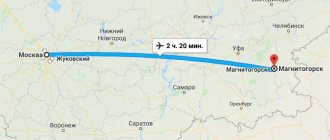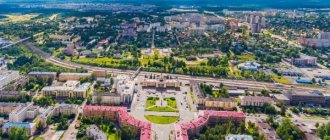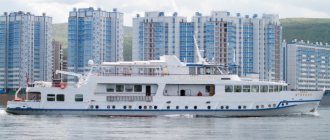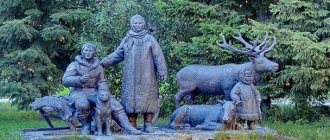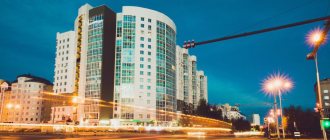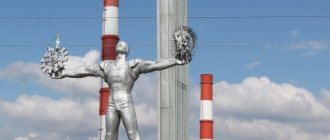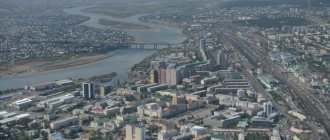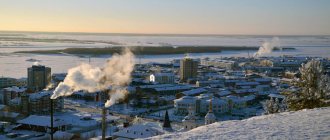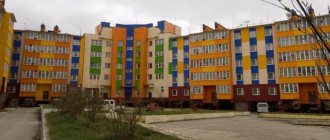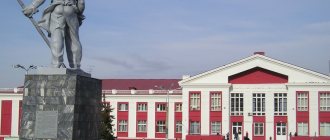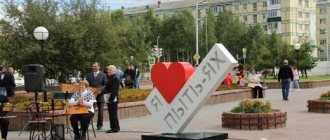A little about Khanty-Mansiysk
Khanty-Mansiysk on the map of Russia is located in Siberia. The total population of the district is 1.5 million people. Khanty-Mansi Autonomous Okrug is included in the list of the most numerous autonomous okrugs in Russia.
Khanty-Mansiysk was founded on December 10, 1930 and was called Ostyago-Vogulsk, because of the residence of northern peoples called “Ostyaks” and “Voguls” in this area. In 1940, the peoples were named “Khanty” and “Mansi”, and the city was named Khanty-Mansiysk.
It is located at the confluence of two Siberian rivers called the Irtysh and Ob, and occupies almost 40 thousand hectares of land. The population of the city is 100 thousand people, of which no more than 10 thousand are indigenous people “Mansi” and “Khanty”.
Khanty-Mansiysk on the map of Russia is surrounded by forests, small lakes and rivers on an area of more than 500 thousand square meters. km. The climate in Khanty-Mansi Autonomous Okrug is brightly continental, with long and harsh winters, with an average temperature of -30 degrees. Summer is short and warm, with sharp frosts, with an average temperature of +18 degrees. For almost 200 days, from October to April, the ground is covered with a half-meter layer of snow.
Great guide to the Khanty-Mansiysk Autonomous Okrug - Ugra
Endless taiga, lakes, wide rivers, birch trees of bizarre shapes growing in swamps, white nights in summer and an amazing low sky. The Khanty-Mansi Autonomous Okrug - Ugra is a region of contrasts, where megacities coexist with the ancestral lands of the Khanty and Mansi, who lead their lives according to centuries-old traditions. The Tutu travel service, together with the Ugra Development Fund, has prepared a large guide to the region: where to live, what to eat and how to have fun in the region.
How to get to Khanty-Mansiysk
Khanty-Mansiysk on the map of Russia is located almost 3 thousand km from Moscow.
There are several ways to get to it:
| By plane | The most convenient way to get to Khanty-Mansiysk is by air. In the early 70s. The air terminal was built in the 20th century; in 2004, the air terminal was given the status of “international”. From here there are flights to more than 60 airports near and far abroad. |
| By train | There is no train station in Khanty-Mansiysk. It is possible to take a train to the nearest train station, located in Nyagan, Pyt-Yakh, and Surgut. |
| By car | At the end of the last century, construction of the route to Khanty-Mansiysk was completed. In 2010, a new part of the road was built through the village of Gornopravdinsk. You can get to Khanty-Mansiysk through Tyumen, Surgut and Nefteyugansk. In 2004, a road bridge was built across the Irtysh, connecting Khanty-Mansiysk with Nyagan and other cities in the west. |
| By steamer | During navigation, Khanty-Mansiysk can be reached along the Irtysh River on a passenger ship. |
Districts and real estate of Khanty-Mansiysk
From the north, the city borders on the many kilometers of the Ob floodplain; from the south, the Irtysh serves as its border. The oldest district is the historical part - Samarovo. The main part of the city is located on the other side of Samarovskaya Mountain, or chugas, as it is called here. New development is taking place in different areas of the city. The youngest microdistricts can be called Yuzhny and Gidronamyv, built on fill soils in the Irtysh floodplain.
There is no official division into administrative districts in Khanty-Mansiysk; established informal names are used for orientation: Samarovo, Rybnikov, Geophysics, campus, TsRM, OMK and so on.
The center is considered to be the area of Engels, Mir, Chekhov, Kalinin, Dzerzhinsky streets. The main streets radiate from the central square of the city, where the local “white house” is located - the government building of the Khanty-Mansiysk Okrug. The center was built up at different times, so here you can see those buildings that can be called elite houses, and wooden houses built in the 60-70s, and private buildings of all kinds - from old wooden houses to cottages. However, not much remains of the old buildings in the center, although the local “Arbat” - pedestrian Marx Street - will remind you of it with a working water pump, to which residents of neighboring houses go for water.
In the center there are offices of the main government services, Ugra State University, the central shopping complex "Gostiny Dvor", museums, television, a large Orthodox church and much more.
Main building of YSU
But Khanty-Mansiysk is a small city, so it’s difficult to say exactly where the center ends.
Komsomolskaya Street - almost the center
Engels Street, which ends at the Bypass Road, doesn’t seem to be the center, but the main square is at most a kilometer away. Here, in the area of Sirina and Roznina streets, there is an area that bears the historical name of CRM (central repair shops). The CRM is a motley mixture of very different houses standing quite closely together: old huts in the private sector, townhouses, five-story buildings, wooden two-story buildings and completely new 12-story buildings. The proximity to the center and developed infrastructure make this microdistrict quite attractive for housing.
View from Chugas to the CRM area
Samarovo, on the contrary, has fairly clear boundaries and guidelines. It also has its own central square, next to which is the Church of the Intercession of the Blessed Virgin Mary, rebuilt on the old foundation.
Church of the Intercession of the Blessed Virgin Mary
At the top of the mountain above Samarovo stands the “Discoverers of the Ugra Land” stele, which houses a restaurant and an observation deck, but now the building is closed - operation turned out to be too expensive. The top of the stele is considered the highest point in the city. Not far from the square there is a river port and a bus station, located in one modern building.
Stele “Discoverers of the Ugra Land”
Now Samarovo is experiencing a rebirth. A lot is being built here: schools, kindergartens and residential buildings. But still, the architectural appearance of the old part of the city is difficult to determine, because it is too colorful and changes quickly. The brick houses near the river port look very respectable, but in Samarovo there are still a lot of standard wooden two-story houses. Along the slopes, clinging to the mountain, there are many different private houses and cottages. Living in Samarovo is not considered very prestigious. There are problems with the school, the streets are not as clean as in the city center, dilapidated housing, etc. From here you can get to the central part of the city either along Gagarin Street, which is over 4 km long, or along the bypass road and Engels Street.
Between Samarovo and the new Yuzhny microdistrict there are several blocks allocated for private housing construction. It would be hard to call this a “cottage community,” because the residents here are building whatever they can within their budget. Over time, this place may become attractive, but now you can’t say anything special about it.
The Yuzhny microdistrict was built over the past 4-5 years on a previously empty site along Obezdnaya Street. Previously, there was an annually flooded floodplain here, and only modern engineering capabilities and large funds made it possible to build a modern multi-story district on bulk soil. The houses here are of different heights - there are 3-4 storey townhouses, 5-storey buildings, and 12-storey buildings. There is a large lyceum-type school and a kindergarten. Nearby there is a water park, an ice palace, and an Archeopark. The place is now very popular among the townspeople, although not everyone likes the constant wind from the Irtysh.
Irtysh embankment near the river station
The same new microdistrict was built in the north of the city – in the area of the campus. Here, university dormitories are compactly located in small five-story buildings, and a tennis center is nearby. The infrastructure is not yet sufficiently developed, although everything necessary is there.
The area of Dunin-Gorkavich Street is probably considered the most prestigious in Khanty-Mansiysk. This street is several hundred meters long and is lined with low-rise red brick houses, designed in the same style. The apartments are very spacious with large windows and glazed loggias, with high ceilings. Oddly enough, there are no elevators in the buildings, so it is not very clear how comfortable it will be for the aging residents of the upper floors to live there. The great advantage of this microdistrict is its proximity to a beautiful coniferous forest that almost surrounds it. The local areas are spacious, with well-equipped children's playgrounds.
The districts of Uchkhoz and OMK are located somewhat away from the city - new housing, often inexpensive, is also being built in them, where residents of dilapidated housing are resettled.
The real estate market in Khanty-Mansiysk is quite lively and is characterized by two main concepts: “wood” and “capital”, referring, respectively, to wooden housing or to housing built from more solid materials. Prices for one-room apartments on the secondary market vary from 1.7-2 million in wooden houses to 4 million in Dunin-Gorkavich. New housing is estimated to be more expensive - a one-room apartment will cost 3.5-4 million in new areas. Prices for two and three-room apartments are relatively lower. So, three rooms in the center in a permanent house can cost from 6 to 8 million rubles, in a wooden one - from 3.5.
There are practically no rooms on the market, but you can rent a room for 15-18 thousand per month. Renting a good one-room apartment will cost 20-25 thousand rubles, a three-room apartment will cost around 40 thousand. Building plots in the city are offered at high prices from 3-4 million for a plot of 7-10 acres in the center to 1.5 million in the Uchkhoz area. For some, the way out of the impasse of housing problems is to buy a beam (trailer), which can cost up to 1 million rubles.
Where to stay in Khanty-Mansiysk
Taking into account your capabilities and preferences in Khanty-Mansiysk, you can choose a hotel from not very expensive to elite:
1. Hotel "Misne" is considered one of the best hotels in terms of price-quality ratio and its location. Payment per day from 4.5 thousand to 8.5 thousand rubles. The price includes breakfast. From the airport terminal to the hotel it is 15 minutes by car.
A local attraction - the Church of the Nativity of Christ is located 400 m away, and there is a biathlon track nearby. The hotel provides a shuttle service and checks in guests 24/7. The rooms have free internet and TV. There is a great view from the window. There is free parking and a cozy bar on site.
2. Mini-hotel "Gamma" . Price per day from 2.6 thousand rubles. The price includes breakfast. The hotel is located 20 minutes from the airport and 10 minutes from the city center. Nearby is the ethnographic museum “Torum Maa”.
The hotel has a shared lounge, free internet and parking on site, and 24-hour check-in. The rooms have a refrigerator and work desk, private bathroom, toilet, TV with cable channels
3. Hotel "Liner" . Price per day from 2.1 thousand rubles. Located 13 km from the biathlon track, 15 km from the cable car. From the airport terminal to the hotel 10 km. The hotel has a 24-hour check-in service.
The hotel provides:
- free Internet;
- parking;
- Private bathroom;
- TV;
- microwave;
- fridge;
- electric kettle;
- coffee maker.
For convenience, the rooms have a desk and a large wardrobe. Pets are allowed. There is a separation between smoking and non-smoking rooms.
4. Guest house "Inn" . Price from 1.8 thousand rubles. per day. The building is located 10 km from the airport terminal, 5 km from the biathlon center and the cable car.
The hotel checks in guests 24 hours a day, provides transfers, free Internet and parking, laundry services, and barbecue facilities. The rooms have TV and bedding. The hotel has a shared shower, toilet, washing machine and ironing facilities.
5. Guest house “On Lugovoi” . Cost from 1.8 thousand rubles. per day. Located 14 km from the airport, 2 km from the ski slope, and 5 km from the biathlon center. The rooms have a desk, TV, electric kettle, microwave, coffee maker. The hotel has a shared toilet, bathroom and kitchen.
Free internet and parking, ironing facilities, transfer are provided, there are special non-smoking rooms. The hotel overlooks the mountain range. There is direct access from the hotel to the ski slopes.
Climate and ecology of Khanty-Mansiysk
Gagarin Street cuts through the well-preserved taiga massif of Samarovskaya Mountain
The ecological situation in the city is very favorable, because there are no large industrial enterprises here. Since most houses are heated by small gas boilers, this source of pollution can be neglected. Perhaps the main polluter is motor transport, but even here it’s not all that bad – the population is small, and there is not much transit transport. The cleanliness of the air can be judged by the color of the snow - here it remains almost white all winter. More than a third of the city's territory is occupied by parks and natural plantings.
Where to eat in Khanty-Mansiysk
Khanty-Mansiysk is a city of contrasts. Despite its location on the map of Russia in Siberia, in restaurants you can find dishes of a variety of cuisines to suit every taste.
1. The Kinza restaurant is located in a beautiful old building in a picturesque park on the street. Dzerzhinsky. This is a family restaurant serving Georgian cuisine.
Here you can taste:
- khachapuri;
- satsivi;
- khinakali;
- dolma;
- various cheeses;
- a huge amount of greenery;
- shashlik;
- Home wine;
- chacha;
- freshly prepared compotes.
The inside of the restaurant is decorated in an oriental style, with brightly colored ceramic dishes.
2. Bar-restaurant “Freestyle” on Sportivnaya Street presents European and Russian cuisine, with the addition of local colorful products such as sterlet, muksun, venison and mushrooms.
Oriental sauces are always present in the preparation of dishes:
- gamadari;
- teriyaki;
- B-B-Q;
- brinjal;
- black pepper.
Restaurant specialties:
- baked nelma stroganina;
- rack of lamb;
- mushroom and potato muksun.
The restaurant has a summer outdoor terrace, which offers a beautiful view of the Siberian landscape.
3. “Taiga Dead End” is the most popular restaurant in Khanty-Mansiysk on the Tobolsk tract. This is a truly Russian restaurant that serves dishes prepared according to Siberian and Old Russian recipes.
Here you can taste the following dishes:
- pancakes with red caviar;
- salted mushrooms;
- stroganina from nelma and muksun;
- Siberian dumplings with sour cream, stewed in pots;
- baked quail and hazel grouse;
The interior of the room is decorated with antique samovars, wooden furniture, woven rugs and scarves.
Architectural landmarks
1. “Archeopark” in Khanty-Mansiysk is located in the southwest, at the foot of the “Pioneer Mountain”. This is a branch of the “Museum of Nature and Man”, organized in an open space of 4 hectares. The cliff of Pionerskaya Mountain, or rather the Samara outlier, is a world-famous geological object; “Samarov Town” is an archaeological monument.
The rocks sticking out of it are exposed ancient rocks. Sculptures of mammoths and representatives of ancient peoples installed at the foot of the park complement the unique atmosphere of the park. Near the territory of the Archeopark, a small area of taiga with an untouched landscape has been preserved.
2. Art Museum . Construction of the Art Museum building began in 2006, according to the design of the artist, Sergei Goryaev, and lasted almost 7 years. The design of the institution's style and logo was developed by Sergei and Natalya Lozovy, who were members of the Union of Designers of Russia. The opening took place in the summer of 2011. This building is recognized as an architectural landmark of Khanty-Mansiysk.
3. Orthodox complex. Erected according to the traditions of the 18th and 19th centuries, the building of the Orthodox complex “In the Name of the Resurrection of Christ” is of great value. This complex consists of 10 buildings. Nearby are architectural monuments of saints, sculptures on the theme of biblical commandments, and the park of literature and culture “Slavyanskaya Square”.
4. Theater "Sun" . The only theater in the world about the indigenous northern peoples, called “Theater of the Ob-Ugric Peoples Sun”, is famous throughout the world. It opened in early 2002 and immediately created a sensation. The actors perform in the native language of the Khanty and Mansi peoples and use throat singing techniques.
5. The natural and architectural park “Barsova Gora” has a length of almost 9 km along the right bank of the Ob River and rises 30 m above the river’s edge. For 7 thousand years people lived in this place. They left many valuable antiques, traces of their existence, which have been mined and studied by archaeologists over the past 100 years.
Monuments
1. Monument to the “Discoverers of the Ugra Land.” Located at the address: Pioneer Passage, Building 1, it is the largest project in recent years. The monument is made in the form of a glass pyramid. Its height is more than 60 m.
It is divided into 3 parts, each of which symbolizes a certain period of time in the history of Khanty-Mansiysk:
- ancient times of the city;
- the era of the development of places by Ermak’s squad;
- discovery of new oil and gas fields.
The monument, thanks to its installation on the slope of a hill, is visible from anywhere in the area. From the observation deck at its top there is a beautiful view of the forest surrounding it and the Irtysh River.
2. The sculpture “Bronze Symbol of Ugra” or by its name “Many Faces of Ugra” was installed at the end of 2005, in honor of the 75th anniversary of Khanty-Mansiysk.
It is installed in the city center, next to the Administrative and Government buildings. The monument depicts a woman standing on a high pedestal, decorated with traditional national patterns. Its height is 12 m. At the foot of the pedestal there are small sculptures of the peoples of the North and oil workers working at the stations.
3. A very popular monument among tourists is installed in the city center and is called “The Hunt Family at a Rest.” This life-size sculptural composition with a certain flavor of the past depicts the Khanta family.
In the center is the head of the family, sitting on a sledge, with his family nearby: his wife and child. A little to the side are a deer and a dog that belong to them. In the evening, the composition is illuminated by multi-colored spotlights.
4. The monument to A.S. Pushkin and Natasha Goncharova was made by order of the city. The production was supervised by the famous artist Andrey Kovalchuk. The installation of the monument took place in the summer of 2007 near the Ugra - Classic concert hall, in honor of the year of the Russian Language and the 425th anniversary of Khanty-Mansiysk.
The installed bronze sculpture of Pushkin and Goncharova is life-size. Natalia, sitting on a bench, is holding a collection of poems by her talented husband.
5. In the “Archaeopark”, 4 km from the city center, there is a sculptural composition called “Mammoths”. This sculpture can be called the calling card of the city.
In 2007, at the time of its installation, it consisted of 7 mammoths cast in bronze, weighing more than 70 tons. In 2009, the composition was supplemented with 4 more mammoths. The height of the largest of them is 8 m, the smallest is 3 m. The sculpture was made in Minsk under the direction of Andrei Kovalchuk.
Religious sites
1. One of the significant religious attractions of this area is the Church of the Resurrection of Christ. It rises on a high hill on the right bank of the Irtysh. Construction of the temple began at the end of the last century and lasted 5 years. The temple is the center of the spiritual and religious life of the district and an interesting architectural structure.
Center of spiritual and religious life of Khanty-Mansiysk - Church of the Resurrection of Christ
The building is made in the traditions of Russian architecture of the late 19th century. The temple and the bell tower installed on it are the tallest city building (total height 63 m). An Orthodox park is located around the building on an area of more than 1.5 hectares.
2. In the southern district of the city, in Samarovo, the Church of the Intercession of the Blessed Virgin Mary is located. The estimated construction date of the cathedral is the beginning of the 19th century.
In historical chronicles, the architect is A. Shalgin, who developed the project and built the cathedral with money raised by local residents. In Soviet times, the temple was looted and destroyed. Restoration work on the Temple began in the fall of 1996 and lasted almost 5 years.
General information and a little history of Khanty-Mansiysk
Khanty-Mansiysk, a small and cozy capital of a huge oil region, is located on the right bank of the great Irtysh, only 20 km from the place where it merges with the equally mighty Ob.
Unlike many Ugra cities, Khanty-Mansiysk, although it has a new name, stands in the old “acquired” and “prayed” place. Once upon a time there was a town of the Ostyak prince Samara. In 1637, Tsar Mikhail Fedorovich sent a family of coachmen to settle here to organize the Yamsk race between Tobolsk and Berezovo, and the Samarov town became Samarovsky Yam. Over time, the pier became increasingly important - Samarovo became a large village that played a significant trading role due to its position in the middle of the road to Berezovo and Surgut from Tyumen and Tobolsk. Already at the beginning of the 19th century, a stone Church of the Intercession of the Blessed Virgin Mary was built here.
After the organization of the Ostyako-Vogul national district in 1931, it was decided to rebuild its capital - Ostyako-Vogulsk, 5 km from the village of Samarovo, which became part of the new city. The future Khanty-Mansiysk was built by all sorts of unreliable “elements” exiled here for “reforging”. To this day, the indigenous Khanty-Mansi people still call the area of Roznina Street Perekovka. Ostyako-Vogulsk received its current name in 1940, and became a city in 1950.
On the left is the Tax Inspectorate building, on the right is the Museum of Oil and Gas Geology. The intersection of Dzerzhinsky and Chekhov streets
Museums
1. The largest scientific research center has no analogues in neighboring countries and in Russia. Khanty-Mansi Autonomous Okrug is the first in the country in terms of the amount of extracted natural resources. In 1993, by government decree, the “Museum of Geology” was opened, which later became a museum of federal scale.
In 2003, a new 2-story building was built for the museum. It has an unusual shape; a vertical extension in the shape of a crystal is attached to its façade, and the area in front of the entrance is decorated with a sculpture of a Siberian pioneer.
Due to its unusual shape, the building (according to a note in the SEI publication) was recognized as the most non-standard building of 2000 - 2003. Inside it, on an area of 7 thousand square meters. m. there are more than 35 thousand exhibits. Samples of precious stones, oil production equipment, minerals, and many historical documents are presented.
2. “Museum of Man and Nature” on the street. Mira is a local history museum of the district, built in 1932. It contains historical facts about the life and everyday life of the northern peoples, their clothing, vehicles, weapons, books, and children's toys. Stuffed animals that are extinct and still exist today are presented. In total, the museum displays more than 110 thousand exhibits.
3. Ethnographic Museum Torum Maa , on the street. Sobyanin is the pride of local residents. The museum is located in an open space and imitates the life and way of life of the Khanty-Mansi peoples.
Throughout the entire territory there are houses of local residents in ancient times, the territory is equipped with household items that they used. The opening of the museum took place in 1987 and immediately secured the title of the main attraction of the Khanty-Mansi Autonomous Okrug.
The most interesting and unusual places in Khanty-Mansiysk
In 2008, a fountain in the shape of a designer Faberge egg was installed at the entrance to the Museum of Art. An egg made of pieces of colored opaque glass is installed on a bronze bowl, thanks to which it shimmers in the sun. The fountain is equipped with multi-colored lighting, and in the evening it is a spectacular sight.
The Rotunda fountain, installed in 2003 in the city’s central square, touches on the theme of space. It consists of 2 circles, one inside the other, in the center of which there is a ball imitating the earth. There are 8 columns around the earth, symbolizing the planets of our galaxy.
They hold a large dome that resembles a flying saucer in appearance. The large circle of the fountain is supported by 12 columns, symbolizing the months of the year. The area occupied by the fountain is more than 40 square meters. m.
Where to go with a child in Khanty-Mansiysk
During a family vacation, you need to take care of interesting leisure activities for children:
- On the territory of the Ice Sports Palace, on the street. Ice, there is a water park with 2 swimming pools: an adult and a children's, into which 2 slides of varying heights and lengths descend. There is a separate hot pool with hydromassage. There are sun loungers around the pools. For small children there are slides in the shape of animals, and inflatable toys of different sizes float in the pools.
- There are many petting zoos in Khanty-Mansiysk, where you can not only observe interesting animals and photograph them. Animals can be picked up and petted. Zoo workers are happy to tell visitors about the animals on display and their lifestyle. Special food for animals is also sold here, which can be fed to pets by hand.
- There are many paintball clubs and laser tags in Khanty-Mansiysk, where you can order a family game taking into account the age of the child.
- While spending leisure time together, you can visit the cinema. There are many cinemas in Khanty-Mansiysk, they differ in the number and size of halls, the comfort and convenience of the seats, the presence or absence of a 3D format when viewing.
- As a joint family event in Khanty-Mansiysk, you can visit a bowling alley.
Criminal situation
The criminal situation in Khanty-Mansiysk is not tense. Common urban crimes such as car theft and theft are rather rare here. The Khanty-Mansiysk Department of Internal Affairs reports a downward trend in crime in the city for 9 months of 2012 compared to the same period of the previous year. Here's what the statistics looked like for crime locations: in stores - 62 crimes, in the market - 1, in entertainment venues - 43, in hospitals, clinics, pharmacies - 7, in sports facilities - 13, in cars - 44.
Night Khanty-Mansiysk
For lovers of noisy parties, Khanty-Mansiysk has many nightclubs, for example:
- Entertainment complex “Territory of the First” , located at st. Pionerskaya, 16. The nightclub broadcasts dance music from the 80-90s. in the style of "disco" and "dance". Near the nightclub there is its own free ground parking. The club restaurant serves Japanese, Russian, Italian and European dishes, payment by card is possible. The club provides free internet and a hookah room.
- Night dance bar "Yuna" on the street. Michurina, 6 offers a range of nightly entertainment: dancing, European dishes in the restaurant, a variety of drinks in the bar, playing billiards in a separate room. There is free parking next to the club. Payment by card is possible.
Population of Khanty-Mansiysk
When Khanty-Mansiysk was just beginning to be rebuilt, its population was below 10 thousand people. In the pre-perestroika and perestroika years, the number fluctuated around 30 thousand. Then there was a rather sharp jump upward due to migration, both internal and external.
According to the latest statistics at the beginning of 2014, more than 93 thousand citizens live in Khanty-Mansiysk. The average age of the population is not very high, since many people of working age come to live here. Most of the adult population arrived here from other populated areas of the country, but almost all children can already call themselves natives of the city.
The proximity of modern buildings and private houses is typical for Khanty-Mansiysk. Often built-on floors and trailers in courtyards are rented out to visitors
Now the city is experiencing a real baby boom - the natural increase is one of the highest in the country (14 children per year per thousand population). Also, the population continues to grow due to visitors from different regions - Kurgan, Tyumen, Chelyabinsk regions, Bashkiria, Tatarstan and others. Many come here to work from the Asian republics of the former USSR. By the way, the indigenous inhabitants of the district - the Mansi, Khanty and Nenets - are not often seen here. This is mainly the national intelligentsia working in educational and cultural institutions.
In general, the level of education of residents is quite high, since a very significant part of them work in administrative structures at various levels, in education, culture and in several scientific institutions.
Concert and theater includes a large theater stage and an organ hall
Due to the fact that there are a majority of newcomers in the city, there are no special conflicts on interethnic grounds.
What to see in Khanty-Mansiysk in 1 day
In order to make good use of your time, you need to plan your excursion route in advance:
- A walk along the banks of the Irtysh to the founding sites of Ostyako-Vogulsk.
- Walk along the city embankment along the Irtysh to the River Station.
- Excursion to the Church of the Intercession of the Blessed Virgin Mary.
- Ascent to the heights of Khanty-Mansiysk to the Monument to the Discoverers of the Ugra Land.
- Excursion to the Khanty ethnographic village “Torum Maa”, tasting food cooked according to ancient customs over a fire or in a greased oven.
- Visit to the “Archeopark”, located at the foot of the “Pionerskaya” mountain.
- Evening walk along the Red Dragon Bridge over the Irtysh.
What to see in 2-3 days
Khanty-Mansiysk on the map of Russia occupies a vast territory and is famous for its variety of attractions. To make the most of your time, you need to create an excursion route.
1 day:
- Getting to know the city while walking along the “Ropeway”.
- Visit to the Archeopark and ride on reindeer.
- Visit to the Museum of Oil and Gas Geology.
- Skiing and tubing on the ski slope.
- Walk through the evening city, sightseeing: “Red Bridge”, “Faberge” fountain, “Rotunda” fountain.
Day 2:
- Inspection of the exhibition at the Torum Maa Museum.
- Skating.
- Sleigh ride.
- Inspection of the Church of the Resurrection of Christ.
- Evening walk around the city and inspection of the monuments: “The Hunt Family at a Rest”, “Bronze Symbol of Ugra”, “Monument to the Discoverers of the Ugra Land”.
Day 3:
- Inspection of the local archaeological site “Barsova Gora”.
- A walk through the natural attractions of the Khanty-Mansi Hills, Lake Arantur, Lake Sorovskoye.
- Visit to the Museum of Nature and Man.
Map
| Khanty-Mansiysk: maps |
Khanty-Mansiysk: photo from space (Google Maps) Khanty-Mansiysk: photo from space (Microsoft Virtual Earth)
| Khanty-Mansiysk. Nearest cities. Distances in km. on the map (in brackets along roads) + direction. Using the hyperlink in the distance , you can get the route (information courtesy of the AutoTransInfo website) | |||
| 1 | Poikovsky | 155 (168) | IN |
| 2 | Salym | 168 (353) | SE |
| 3 | Lyantor | 181 (334) | IN |
| 4 | Nefteyugansk | 193 (231) | IN |
| 5 | Uvat (Tyumen region) | 207 (574) | YU |
| 6 | Pyt-Yakh | 208 (248) | IN |
| 7 | Nizhnesortymsky | 215 () | NE |
| 8 | Oktyabrskoe | 225 () | NW |
| 9 | Solar | 225 () | IN |
| 10 | Barsovo | 226 (285) | IN |
| 11 | Nyagan | 228 (295) | NW |
| 12 | Bely Yar | 229 (283) | IN |
| 13 | Turtas (Tyumen region) | 230 (567) | YU |
| 14 | Mezhdurechensky | 233 (563) | SW |
a brief description of
Located in Western Siberia, on the Irtysh (port), 15 km from its confluence with the Ob, 264 km west of the railway. Nefteyugansk station, 1076 km northeast of Tyumen, 2759 km northeast of Moscow.
The climate is continental with long, harsh winters. Average temperatures in January are from -18 to -23, in July +16 +19. Precipitation is about 500 mm per year.
Biathlon center.
Territory (sq. km): 338
Information about the city of Khanty-Mansiysk on the Russian Wikipedia site
Historical sketch
In 1931, 5 km from the village of Samarovo (founded in 1637 as a settlement of coachmen, Samarovsky Yam; named after the Ostyak prince Samara), the village of Ostyako-Vogulsk was founded - the administrative center of the Ostyak-Vogulsky national district. It was part of the Ural region, and since 1934 - the Omsk region.
The workers' settlement of Ostyako-Vogulsk since 1936. Since 1940 it has been called Khanty-Mansiysk (Ostyaks began to be called Khanty, Vogul Mansi), the center of the Khanty-Mansiysk National Okrug. Since 1944, part of the Tyumen region. A city since January 27, 1950, it included the village of Samarovo (5.9 thousand inhabitants, 1939).
Since 1977 - the center of the Khanty-Mansiysk Autonomous Okrug.
Municipal indicators
| Index | 1990 | 1999 | 2001 | 2003 | 2005 |
| Demography | |||||
| Number of births, per 1000 population | 15.3 | 14.9 | 17.8 | 16.2 | 17.6 |
| Number of deaths, per 1000 population | 7.7 | 11.8 | 12.9 | 10.5 | 9.1 |
| Natural increase (decrease), per 1000 population | 7.6 | 3.1 | 4.9 | 5.7 | 8.5 |
| Standard of living of the population and social sphere | |||||
| Average monthly nominal accrued wages, rub. | 0.472 | 4339 | 10474 | 15896 | 22370.1 |
| Average housing area per inhabitant (at the end of the year), sq.m. | 14.5 | 17.8 | 18 | 15 | 16.8 |
| Number of preschool institutions, pcs. | 25 | 20 | 20 | 20 | 19 |
| Number of children in preschool institutions, thousand people | 3.2 | 2.1 | 2.2 | 2.3 | 2.3 |
| Enrollment of children in preschool educational institutions (at the end of the year), as a percentage of the number of children of the corresponding age, % | 62.2 | 57.7 | |||
| Number of daytime educational institutions (at the beginning of the school year), pcs. | 11 | 16 | 13 | 15 | 13 |
| Number of students in daytime educational institutions, thousand people | 5.6 | 7 | 7.1 | 7.1 | 6.8 |
| Number of doctors, people. | 227 | 407 | 449 | 648 | 656 |
| Number of nursing staff, people. | 686 | 996 | 1094 | 1465 | 1362 |
| Number of hospital institutions, pcs. | 4 | 7 | 8 | 8 | 6 |
| Number of hospital beds, thousand units | 0.8 | 1.1 | 1.2 | 1 | 0.9 |
| Number of medical outpatient clinics, pcs. | 7 | 14 | 12 | 13 | 16 |
| Capacity of medical outpatient clinics, visits per shift, thousand units. | 1.3 | 1.6 | 1.6 | 2.2 | 2.3 |
| Number of registered crimes, pcs. | 983 | 1822 | 2720 | ||
| Persons who committed crimes were identified, persons. | 631 | 703 | 941 | ||
| Economy, industry | |||||
| Number of enterprises and organizations (at the end of the year), pcs. | 1543 | 1839 | 1028 | 1570 | |
| Number of operating enterprises by type of activity: mining (at the end of the year), pcs. | 4 | ||||
| Number of operating enterprises by type of activity: manufacturing (at the end of the year), pcs. | 32 | ||||
| Number of operating enterprises by type of activity production and distribution of electricity, gas and water (at the end of the year), pcs. | 16 | ||||
| Volume of shipped goods of own production by type of mining (in actual prices), million rubles. | 11603.4 | ||||
| Volume of shipped goods of own production by type of manufacturing (in actual prices), million rubles. | 1043.9 | ||||
| Volume of shipped goods of own production by type of production and distribution of electricity, gas and water (in actual current prices), million rubles. | 1872.3 | ||||
| Construction | |||||
| Volume of work performed by type of activity “Construction” (until 2004 - volume of work performed under construction contracts), million rubles. | 163.5 | 2017.9 | 3392.4 | 1641.3 | |
| Commissioning of residential buildings, thousand sq.m. of total area | 20.1 | 25 | 75.5 | 79.8 | 61.6 |
| Commissioning of residential buildings, apartments | 326 | 1044 | 1247 | 856 | |
| Commissioning of preschool institutions, places | 0 | 0 | |||
| Commissioning of educational institutions, places | 0 | 500 | 0 | 1150 | |
| Commissioning of hospital facilities, beds | 0 | 0 | 0 | 0 | |
| Commissioning of outpatient clinics, visits per shift | 0 | 450 | 0 | 0 | |
| Transport | |||||
| Number of bus routes (in intracity traffic), pcs. | 8 | 11 | 11 | 10 | |
| Number of passengers transported by buses per year (in intracity traffic), million people. | 5.1 | 9.2 | 9.8 | 5.9 | |
| Connection | |||||
| Number of telephone sets of the city public telephone network, thousand units. | 7.3 | 11.6 | 18.7 | 27 | 30.6 |
| Number of residential telephone sets of the city public telephone network, thousand units. | 4.6 | 7.7 | 10 | 13 | 14.6 |
| Number of payphones of the city telephone network (including universal ones), pcs. | 87 | 138 | |||
| Trade and services to the population | |||||
| Retail trade turnover (in actual prices), million rubles. | 0.072 | 750 | 1235 | 2567 | 4268.5 |
| Retail trade turnover (in actual prices), per capita, rub. | 2.1 | 19996 | 31257 | 46675 | 73090.1 |
| Index of physical volume of retail trade turnover, % compared to the previous year | 139 | 118 | |||
| Index of physical volume of public catering turnover, % compared to the previous year | 103 | 114 | |||
| Number of stores, pavilions (at the end of the year), pcs. | 48 | 35 | |||
| Sales area of shops, pavilions (at the end of the year), sq.m. | 7115 | 4325 | |||
| Volume of paid services to the population (in actual prices), million rubles. | 0.013 | 209.6 | 504 | 1093.6 | 1808 |
| Volume of paid services to the population (in actual prices), per capita, rub. | 0.4 | 5590 | 12760 | 19883 | 30958.8 |
| Volume of household services to the population (in actual prices), million rubles. | 0.002 | 29.6 | 58.5 | 85.1 | 121.4 |
| Volume of household services to the population (in actual prices), per capita, rub. | 0.1 | 789 | 1480 | 1547 | 2079.1 |
| Investments | |||||
| Investments in fixed assets (in actual prices), million rubles. | 0.055 | 1192.6 | 10270.4 | 16793.2 | 17208.9 |
| Share of investments in fixed assets financed from budgetary funds in the total volume of investments, % | 57.4 | 75.4 | 51.1 | 33.6 | |
Data sources:
- Regions of Russia. Main characteristics of the constituent entities of the Russian Federation: statistical collection. Goskomstat of Russia. - M:, 2003.
- Regions of Russia. Basic socio-economic indicators of cities. Statistical collection. Rosstat. - M:, 2005. p. 277
- Regions of Russia. Basic socio-economic indicators of cities. 2006. Statistical collection. Rosstat. - M:, 2006. p. 273
Economy
JSC "Aqua" (former fish canning plant), wood processing plant, food processing plant, bakery, dairy.
In the Khanty-Mansiysk region, potatoes are grown, and vegetables are grown in small quantities (in open and closed ground). They raise cattle and pigs. Animal husbandry (silver-black fox, arctic fox, mink).
Near Khanty-Mansiysk there is a large oil field (Priobskoye). Clay deposits.
Main enterprises
AGRICULTURAL PRODUCTION
JSC "National Ugra"
626200, Khanty-Mansiysk Autonomous Okrug - Ugra, Khanty-Mansiysk, st.
Lenina, 108 Offers:
Eggs and chicken meat
INLAND WATER TRANSPORT
OJSC "Khanty-Mansiysk River Port"
626200, Khanty-Mansiysk Autonomous Okrug - Ugra, Khanty-Mansiysk, st.
Koneva, 18 Offers:
ELECTRIC AND RADIO COMMUNICATIONS
OJSC "Khantymansiyskokrtelecom"
626200, Khanty-Mansiysk Autonomous Okrug - Yugra, Khanty-Mansiysk, st.
Comintern, 3 Offers:
Telecommunications, broadcast of television and sound programs, cellular radiotelephone communications
Culture, science, education
Research Institute for the Revival of the Ob-Ugra Peoples (since 1991).
Faculties of the Tyumen Agricultural Institute and Nizhnevartovsk Pedagogical Institute.
Museum of Local Lore.
Universities of the city
Khanty-Mansiysk State Medical Institute
628012, Khanty-Mansiysk Autonomous Okrug - Ugra, Khanty-Mansiysk, st. Roznina, 73 WWW: https://www.hmsmi.ru/
Khanty-Mansiysk Institute of Design and Applied Arts (branch) of the Ural State Academy of Architecture and Art
628012, Khanty-Mansiysk Autonomous Okrug - Yugra, Khanty-Mansiysk, st. Piskunova, 1
Khanty-Mansiysk branch of the Institute of Management (Arkhangelsk)
628011, Khanty-Mansiysk Autonomous Okrug - Ugra, Khanty-Mansiysk, Nadezhdy Ave., 10
Khanty-Mansiysk branch of Moscow State University of Culture and Arts
628012, Khanty-Mansiysk Autonomous Okrug - Yugra, Khanty-Mansiysk, st. Piskunova, 1
Khanty-Mansiysk branch of the Russian Academy of Music named after. Gnessins
628012, Khanty-Mansiysk Autonomous Okrug - Yugra, Khanty-Mansiysk, Piskunova St., 1
Khanty-Mansiysk branch of the Ural Institute of Commerce and Law
628007, Khanty-Mansiysk Autonomous Okrug - Yugra, Khanty-Mansiysk, st. Mira, 51
Ugra State University
628012, Khanty-Mansiysk Autonomous Okrug - Yugra, Khanty-Mansiysk, st. Chekhova, 16 WWW: https://www.ugrasu.ru/
Museums, galleries, exhibition halls
Gallery-workshop of the artist G.S.
Raisheva 628011, Khanty-Mansiysk Autonomous Okrug - Ugra, Khanty-Mansiysk, st. Mira, 2 block "C" Phone(s) Website: https://raishevgm.ru/ House-Museum of the People's Artist of the USSR V. A. Igoshev 628012, Khanty-Mansiysk Autonomous Okrug - Ugra, Khanty- Mansiysk, st. Lopareva, 9-a Phone(s): (34671) 2-4000
Museum of Nature and Man 628011, Khanty-Mansiysk Autonomous Okrug - Ugra, Khanty-Mansiysk, st. Mira, 11 Phone(s) Website: https://www.ugramuseum.ru/
Museum of Geology, Oil and Gas 628012, Khanty-Mansiysk Autonomous Okrug - Ugra, Khanty-Mansiysk, st. Chekhova, 9 Phone(s) Website: https://www.muzgeo.ru/
Khanty-Mansiysk Ethnographic Museum-Reserve 626200, Khanty-Mansiysk Autonomous Okrug - Ugra, Khanty-Mansiysk, st. Sobyanina, 1 Phone(s): (34671) 2-2058
Ethnographic open-air museum “Torum Maa” 628012, Khanty-Mansiysk Autonomous Okrug - Ugra, Khanty-Mansiysk, st. Mekhanizatorov, 2B-2 Phone(s) Website: https://torummaa.ru/
Architecture, sights
Wooden buildings from the 1930s have been preserved.
Near Khanty-Mansiysk there is an open-air museum “Torum-Maa” (architecture of the peoples of the north).
In the Khanty-Mansiysk region, natural monuments are the Valley of Streams, Samarovsky Hill (Ust-Irtysh Mountain).
| Population by year (thousands of inhabitants) | |||||||
| 1939 | 7.5 | 1996 | 34.6 | 2007 | 63.2 | 2015 | 95.4 |
| 1959 | 20.7 | 1998 | 34.6 | 2008 | 67.8 | 2016 | 96.9 |
| 1967 | 24 | 2000 | 37.7 | 2010 | 75.9 | 2017 | 98.7 |
| 1970 | 24.8 | 2001 | 38.7 | 2011 | 80.2 | 2018 | 98.5 |
| 1979 | 28.3 | 2003 | 54.0 | 2012 | 85.0 | 2019 | 99.4 |
| 1989 | 34.5 | 2005 | 57.3 | 2013 | 91.0 | 2020 | 101.5 |
| 1992 | 35 | 2006 | 59.6 | 2014 | 93.5 | 2021 | 103.1 |
Winter tourism
If your visit to Khanty-Mansi Autonomous Okrug falls in the winter period from December to March, it is worth visiting the main event of the season - “Ice Town”. For 12 years, on New Year's Eve in Khanty-Mansiysk, a huge “Ice City” has been built on the central square.
The artist Pavel Verkhonostsev came up with the idea and brought it to life. From huge blocks of ice, craftsmen cut and carve sculptures of animals and fairy-tale characters, and pour huge slides 4 m wide and up to 40 m long.
If the winter is not very cold and there is not enough ice on the river, the frame of the slide is made of wood, then fastened together and filled with water. The opening of the “Ice Town” with the solemn procession of Father Frosts and Snow Maidens takes place on the 10th of December.
Infrastructure condition
Living in Khanty-Mansiysk in modern houses is very comfortable - they are perfectly adapted to Siberian frosts. Plastic windows and balcony glazing are installed as standard in all new houses. The radiators are always hot, because instead of district boiler houses and long heating mains running from them, there are small automatic gas boiler houses everywhere that heat one or more neighboring houses. Such boiler rooms are located next to the house or on its roof, take up almost no space and can be easily dismantled when they are no longer needed.
Water supply can serve as a source of pride for the Khanty-Mansi people. The local water supply system supplies homes with the purest water purified using modern technologies without the use of chlorine. The water is soft - it leaves almost no scale in kettles and no sediment on plumbing fixtures.
The stoves in new houses are also often gas, which is convenient because gas is cheap. Electricity meters everywhere are installed with two tariffs, which also makes it possible to save money.
New house on Ledovaya Street in the Gidronamyva area
In general, in a new apartment the owner will find not one meter, but 4-5: for gas, cold and hot water, for heat and electricity. Gas and electricity are paid separately - the most convenient way to do this is through an ATM or the Internet. The bill for all other utilities in a one-room apartment will be from 2,500 rubles. If the service company takes into account the readings of heat meters, then you will have to pay less, because the radiators can be easily adjusted to the desired temperature. In old and dilapidated housing, not everything can be so rosy - there are still houses with stove heating, water from a pump and with latrines on the streets. What can we say about trailers and garage superstructures poorly adapted for housing, but people live there too.
There are still a lot of such houses in Khanty-Mansiysk
The city authorities are doing a lot to improve the street road surface. Local road and municipal services maintain a large fleet of special equipment for cleaning and repairing streets, so the roadway is in good or even excellent condition, which often cannot be said about sidewalks. They may be completely absent, lined with humpback tiles (hello Moscow!), or partially destroyed. The snow on the sidewalks of many streets is not removed before the snow begins to melt, and a lot of snow also accumulates in the courtyards.
Many Khanty-Mansiysk residents drive their own cars, but there are almost no traffic jams, unless you call it a traffic jam when driving not at the first traffic light, but at the next one. This picture can indeed be observed during rush hour, at the beginning and end of the working day.
Public transport can be safely given a 4 – the traffic is regular, on schedule, but the intervals are still long. This is especially noticeable in cold weather. In addition to several bus routes, there are quite a few minibuses. A regular taxi is also available to most residents - the prices are not high.
Although kindergartens are being built in Khanty-Mansiysk, the provision of preschool institutions is a sore point for young families. It is possible to place a child in kindergarten on a first-come, first-served basis at 3-4 years of age, or it may not be possible at all. The usual way out of this situation is to hire a nanny, an unusual one is to enroll the child in a rural kindergarten in the village of Shapsha, which is 20 km from the city. And this happens.
This high-tech building is a kindergarten
There are 15 schools in the city, all of them are quite large, but they, apparently, will soon not be enough - children grow up quickly.
What to bring from Khanty-Mansiysk
The best gift brought from Khanty-Mansiysk is a local household item or a national souvenir:
- Local residents are famous for sewing leather and fur products. As a souvenir, you can buy a colorful hat or fur vest in the store. Untas are national fur winter shoes that can withstand frosts down to -50 degrees, pimas are felt boots made from felted sheep wool, rovdugs are national summer shoes made from reindeer skin.
- Craftsmen weave funny rhizomes (like baskets) of various shapes and sizes from cedar roots and grass. They are used as boxes and caskets. Various jewelry and souvenirs are made from wood and bones, using fur and beads.
Khanty-Mansiysk is an amazing city, the local traditions and nature of which are very different from the traditions and nature of central Russia.
But, despite the distance on the map, traveling along this route will leave an unforgettable impression.
Author of the article: Olga Zhanskaya
Article design: Svetlana Ovsyanikova
